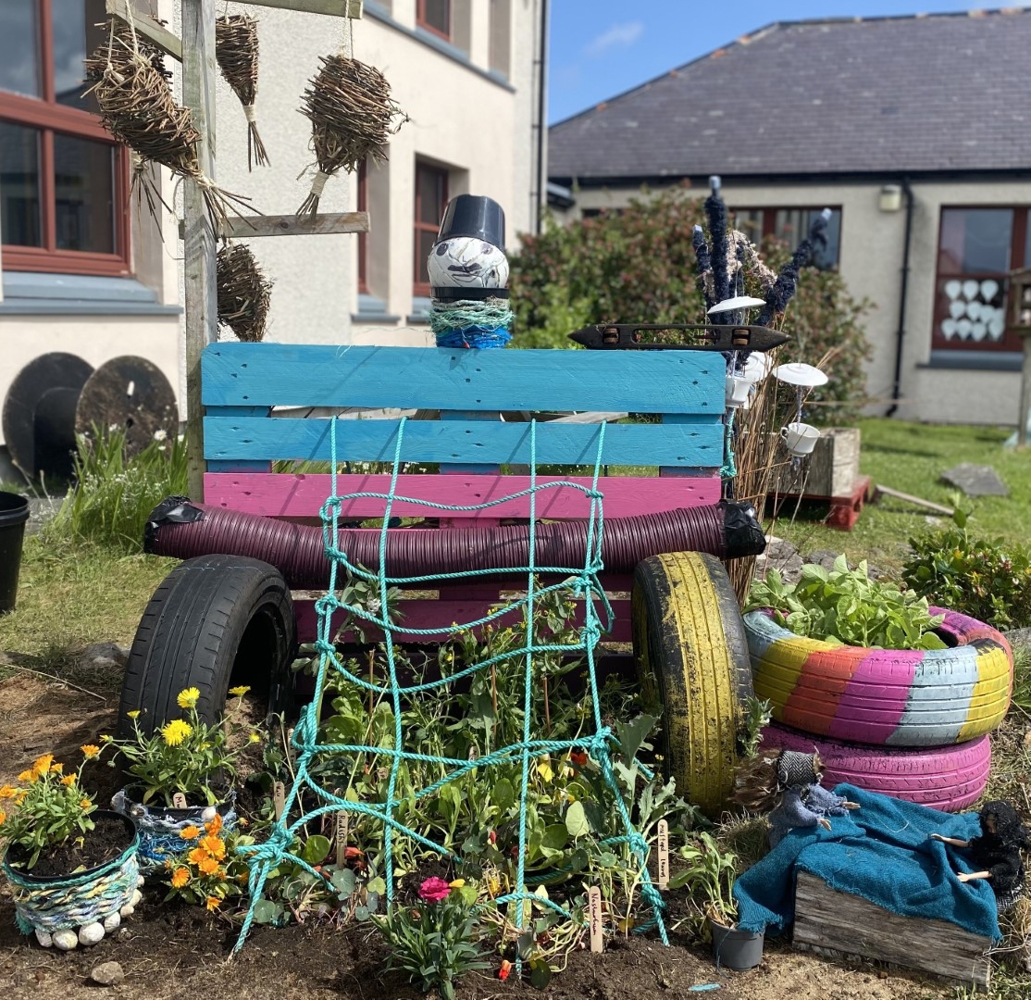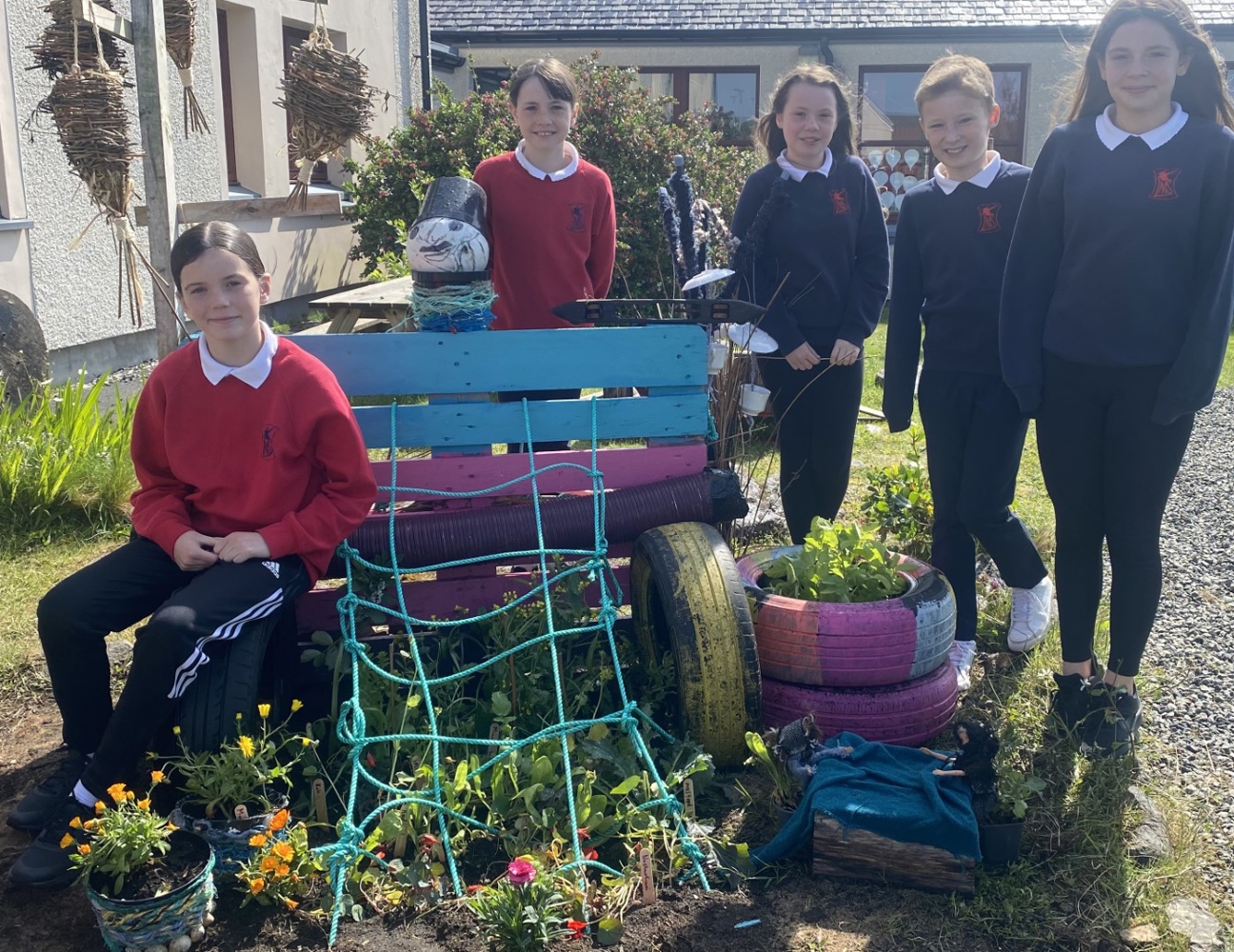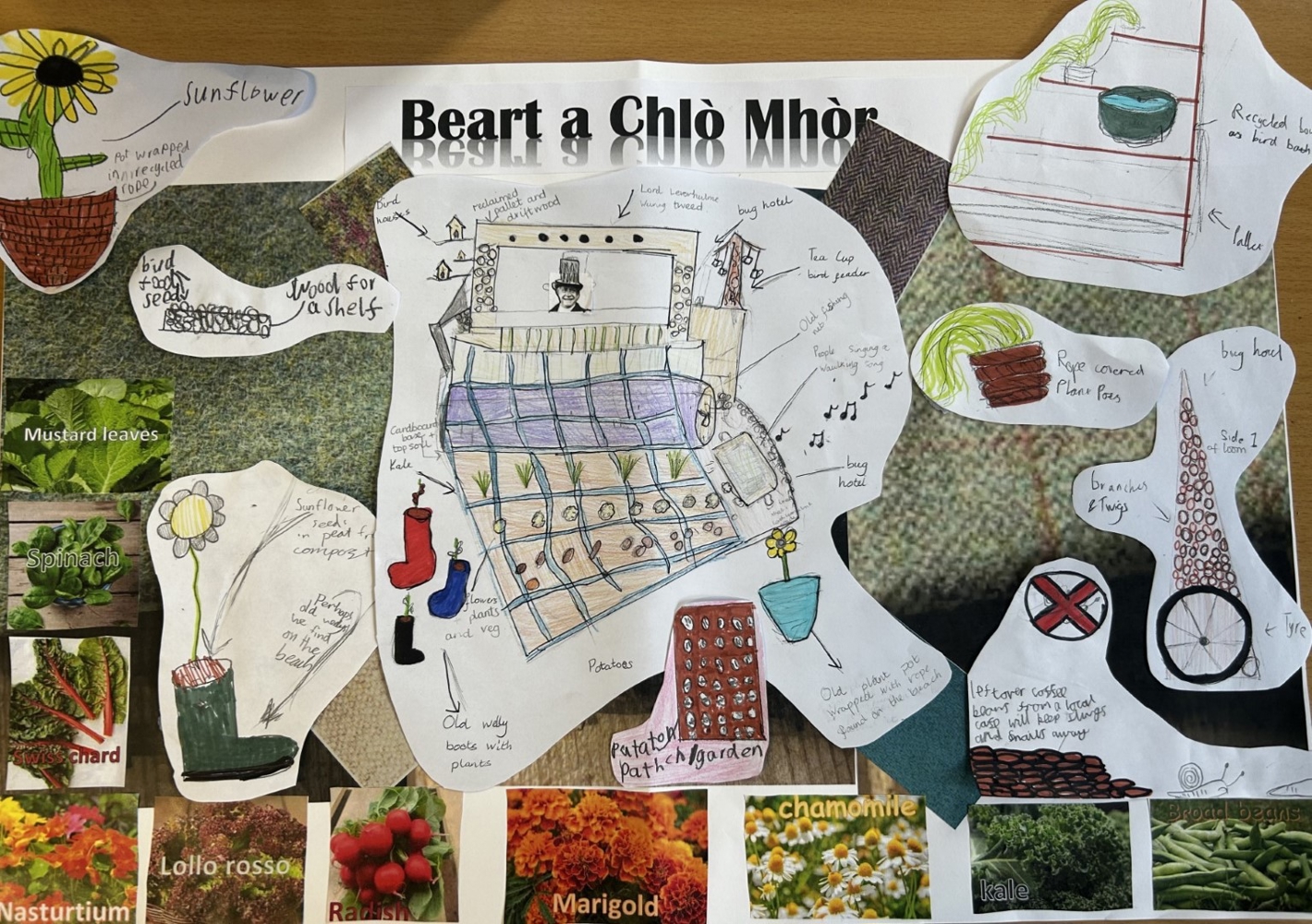Leverhulme Memorial Primary, P5-7 Harris Tweed
Leverhulme Memorial Primary, P5-7 Harris Tweed

We live on the Isle of Harris. Harris is known for it’s beautiful beaches, machair wildflowers and the famous Harris Tweed or Clò Mhòr as we know it in Gàidhlig. When we thought of Nature’s weavers, it made us think of the Harris Tweed weavers who have been part of our heritage and culture for over a century. Some of our friends, family and parents weave Harris Tweed so this inspired us to thinking of creating a Harris Tweed Loom Pocket Garden.
Our finished loom
Hopefully the garden will attract bees, butterflies and birds. We hope that the plants will continue to grow here to allow the bees to get the pollen from the flowers and add colour to the garden and that the bugs like their wee hotels to live in. We packed the back of our pallet with leftover willow, driftwood, stones and grass for our bug hotel.
We have all enjoyed this project. It has allowed us to make links with several people in our local community. We have enjoyed our trips to the beach, the polytunnel and having visitors into the school to teach us new skills. A lot has been trial and error which has been a valuable lesson too. We have enjoyed sawing, painting and planting the plants in our garden.
We were very fortunate to have had the support of our local community, including local businesses such as Temple. Matt and Alexander from Temple visited us in school and we learned about what plants and flowers would flower in time here in Harris within the competition timeframe. They showed us organic growing techniques and let us use a space in their polytunnel.
Pupils tell their garden story and how local businesses and a beach clean helped
Oran na Beart is the name of song on our presentation. It is a Gaelic song by Island folk group called The Lochies. Oran na Beart translates into Song of the loom and the noise you hear in the background is the sound of someone weaving the tweed on the loom. A perfect song to showcase our very own loom.
A local crofter kindly donated the pallets to us and we used leftover paint from other school projects. For the piece that the tweed falls off we used a flue pipe from a fire that we found. We did ask around to see if anyone had lost one but nobody did!
Bird houses
We had originally thought about making wooden bird houses using driftwood. We were advised to think about creating a version of a weaver bird's nest using chicken wire and grass, straw, or string. We knew just the people to ask to help us. We got in touch with another local business, Croft 36. Steve and his son Finlay came into school with freshly cut willow and taught us all how to make a weaver’s bird nests. It was quite tricky but great to learn a new skill. We really hope that the birds will come to the nests that we have made for them. We think that they look amazing and more sustainable.
Organic techniques
We used leftover coffee beans from a local organic cafe and sand to spread around the circumference of the garden as slugs and snails don’t like coarse materials.
The pocket garden is dug straight into the soil, currently there is grass so will use no-dig gardening technique where we put down cardboard and 6 inches of peat free compost. This technique has been shown to improve soil health compared to digging.
We visited the poly tunnel in Northton to plant our seeds. We kept visiting the poly tunnel to check on our plants and to repot them once they started growing. We planted a variety of plants and flowers. Some grew but others not so much.
What we planted
A garden of flowers and vegetables , all edible.
• Pot Marigold to bring vibrant yellows, a fantastic plant that has edible petals great to add colour to salads and the more you pick the flower heads the more they grow back.
• Nasturtium a plant where all leaves and flowers and seeds are edible. This gives the pocket garden some height in a small plot where it will grow along upcycled fishing nets.
• Chamomile this will offer tints of white and yellow amongst the green tartan and can picked to make tea with
• Kale will provide the greens to the tartan
• Radish can provide a different shades of green to the tartan
• Broad Beans - along with the nasturtium will be grown up the upcycled fishing nets.
• Lollo Rosso will provide reds and can help give distinctive lines in the pattern.
• Mustard leaves offering more colour and edible options.
• Spinach using perpetual spinach this cut and come again vegetable will be perfectly ready for May.
• Swiss chard this multicoloured plant will add more fantastic colour to the garden.
Construction
We had to dig lots! First we had to think carefully about the location of our pocket garden. It had to be situated somewhere sheltered that also got the sun. Once we decided on it’s location we measured out the area to dig and turn over the soil and added compost to the site. Finally we added the cardboard on top to supress the weeds. We had to put big stones on it to make sure the wind didn’t blow it away. We had planned to anchor the loom with two fence posts to support to the structure. We started digging 2 holes however disaster struck. We hit rock bottom. We had to dig the length between the 2 holes in order to see if it was one massive rock on the bottom or just lots of smaller rocks. The thinking cap went back on and then we decided to use the trench that we now had and we placed pallet into it. We buried the bottom into the ground to secure it.
Waulking the tweed
Once Harris Tweed is finished on the loom it is very stiff and the weave is quite loose. Traditionally, groups of women would “Waulk the tweed”. This would involve soaking the tweed and beating it rhythmically to shrink and soften it. They would sing as they were waulking the tweed and it was a sociable time for the ladies. Our design includes 2 designer Barbies, dressed in handmade tweed outfits made from offcuts of local tweed. They can be seen at the front of the loom waulking the tweed.
Tea cup bird feeder
We had seen lots of bird feeders using tea cups and wondered how we could incorporate them into our garden. We visited our local charity shop to get some second hand cups and saucers and had the idea of hanging them somehow. They only cost us £6.00 for a set! To make the holes in the cups and saucers we asked Harris Glass Studio if they could help us as we didn’t have the necessary tools. We are looking forward to working with Harris Glass Studio again when they come in to do a whole school glass workshop where we will be making coasters. The local charity shop gave us some free wire coat hangers for us to secure our cups and saucers to. Our next challenge was securing them in place. We used glue in the end but also wrapped string and wool around the metal part for extra support.
We did a local community clean up and looked down at the shore beside the pier but sadly only found one chewed up rotten piece of rope. A local fisherman kindly donated a brand new long piece of really good rope. We collected more rope, drift wood and other bits and bobs for the bug hotel when we did a beach clean up on Northton Beach. That was very successful, we collected about 6 boxes of wood, rope and other trinkets. We used the rope and sea shells collected to upcycle plant pots that we used for some of our plants.
Lord Leverhulme
We had recently done a big topic on Lord Leverhulme who owned our village around 100 years ago. This topic included a big stage performance with proper lights, sound and costumes. Our school is even named after him, Leverhulme Memorial School. This is why we chose him to be our weaver. We used an old football to create his head and a plant pot for his hat. He was also known as the Soapman with his company Sunlight soap. The Temple had recently come in to school to make machair flower soap with us and our own lip balms using plants and flowers grown local.

We will continue to care for our garden through our Eco committee and look forward to seeing it grow.
We are very thankful to lots within our local community. Thanks to Matt, Caroline, Alexander and Amanda at The Temple for their soap workshop, advice and space to grow our plants. Matt has paid frequent visits to help us with the construction of our loom which we are grateful. Thank you to Steve and Finlay from Croft 36 for teaching us how to weave the willow birds nests. Thanks to Debbie at Harris Glass Studio for drilling our tea cups. Thank you to parents who have also donated time or items for upcycling as part of our garden.


